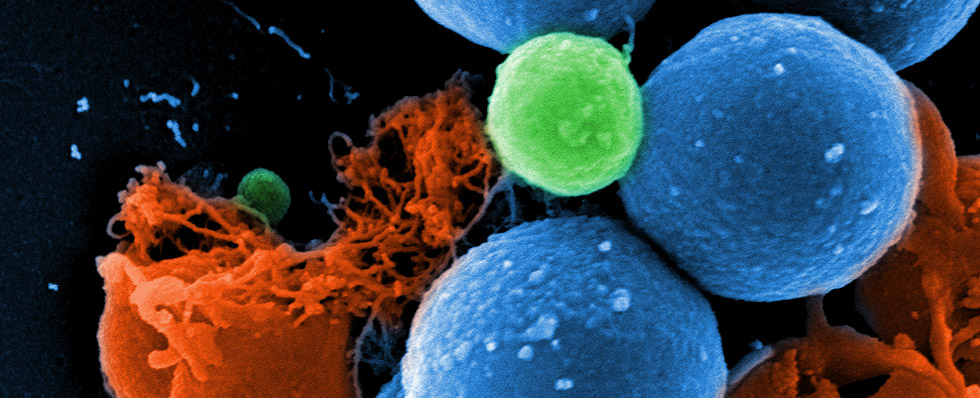Antibiotic resistance occurs naturally in bacteria as a mechanism to defend themselves and survive in the course of evolution. However, due to the large-scale and often erroneous use of antibiotic drugs, antibiotic resistant pathogens are becoming more widespread. Infections with multi-resistant pathogens that can withstand several types of antibiotics are frequently difficult to treat. Staphylococcal strains that are resistant to several antibiotics including methicillin (MRSA) are now common, and infections caused by these multi-resistant staphylococci are also on the rise. “The development of new antibiotics by the pharmaceutical industry has been slowed down several years ago and, therefore, cannot cope with the spread of antibiotic resistance. We urgently need innovative approaches to address the need for new infection treatments that do not immediately lead to development of resistance,” says Prof Eva Medina, head of the research group “Infection Immunology” at the HZI.
Testing already existing and approved human drugs for a potential anti-microbial effect on bacteria is a promising strategy. “Our focus was on a class of human proteins, kinases, for which there are already many inhibitors,” says the leader of the study, Prof Stephan Sieber, Professor for Organic Chemistry at the TUM and scientifically associated with the Helmholtz Institute for Pharmaceutical Research Saarland (HIPS), one of the HZI sites in cooperation with the Saarland University. Sorafenib, a cancer drug that is effective against MRSA, was systematically chemically modified by the researchers to increase its antibiotic effect. In this way, they developed the molecule PK150, which is ten times more effective against MRSA than the original substance.
The potent new drug acts against multiple unconventional target structures in Staphylococcus aureus. Two targets were investigated more closely: PK150 inhibits an essential protein of the bacterial energy metabolism and also acts on the cell wall. In contrast to well-known antibiotics such as penicillin and methicillin, which interfere with the formation of the cell wall, PK150 acts indirectly. It disrupts the protein secretion of the bacteria, causing the bacteria to release more proteins, which control the thickness of the cell wall, causing cells burst. “Due to the chemical changes in the molecule, PK150 no longer binds to human kinases, but instead acts very specifically against bacterial targets,” says Sieber.
Medina and Dr Katharina Rox, pharmacologist in the department “Chemical Biology” at the HZI, showed that PK150 exhibits beneficial pharmacological properties. For example, it could be given as a tablet and is stable in the body for several hours. In an infection model in mice (in vivo), PK150 was effective against Staphylococcus aureus in different tissues. While staphylococci can rapidly develop resistance to other antibiotics, the researchers did not observe any resistance to PK150. Prof Dietmar Pieper, head of the research group “Microbial Interactions and Processes” at the HZI, explains that the simultaneous development of resistance at several targets is much more difficult for bacteria. “MRSA infections are frequently chronic, because the bacteria can fall into a resting state. PK150 also kills these long-lasting persister cells as well as those bacteria, which are protected in biofilms. PK150 has many properties that make it a promising antibiotic candidate,” says Sieber. In order to move into the clinical development phase, PK150 is currently being optimised by aBACTER, a project funded by a VIP+ grant of the Federal Ministry of Education and Research.
Original publication:
Philipp Le et al: Repurposing human kinase inhibitors to create an antibiotic active against drug-resistant Staphylococcus aureus, persisters and biofilms. Nature Chemistry 2019, doi: 10.1038/s41557-019-0378-7

